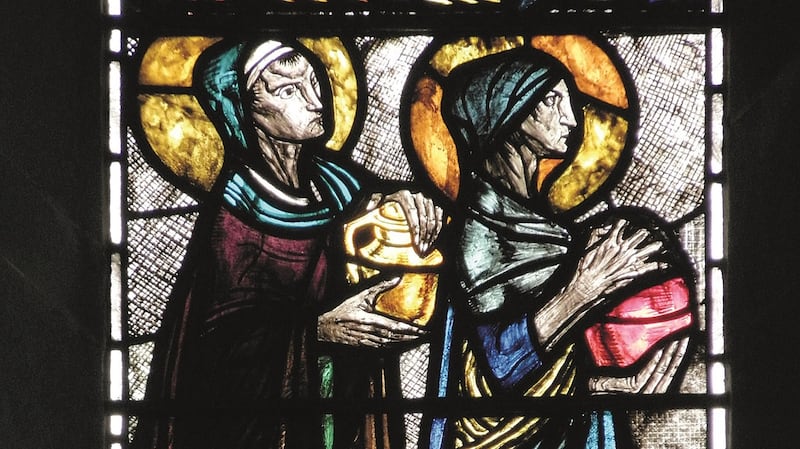The work of stained-glass artist Wilhelmina Geddes (1887-1955) is reaching more and more people as a result of the new book on her life and work by Nicola Gordon Bowe, associate fellow of the National College of Art and Design and expert in the Arts and Crafts movement in Ireland and Britain.
One of the most valuable attributes of academic researchers is their dedication to original sources and their patient and often painstaking attention to seeking out new information about their subjects. Both of these attributes are clearly evident in Gordon Bowe's book which was chosen by the Irish Times art critic Aidan Dunne as his art history book of the year for 2015.
Geddes was the focus of a recent talk by Gordon Bowe for the Irish Georgian Society (IGS).

While widely acknowledged as a vital figure in the Irish Arts and Crafts movement and 20th-century British stained-glass revival, Geddes was forgotten after her death. In fact, throughout the latter half of the 20th century, the stained-glass art of Geddes was overshadowed by the better-known stained-glass artist Evie Hone. But, Gordon Bowe's mission is to change that view and her encyclopaedic knowledge of the Arts and Crafts movement adds gusto to that mission.
Geddes was the eldest of four children, born in 1887 in Co Leitrim but raised in Belfast. She studied at the Belfast School of Art and later in Dublin, under the painter William Orpen. She was invited by Sarah Purser to join An Tur Gloine (Tower of Glass), a co-operative stained-glass studio where she worked for several years. When she was 38, she moved to London and worked at the Lowndes & Drury's Glass House in Fulham for the next 30 years where her pupils included Evie Hone. She never returned to Ireland.
Gothic and Greek
At the IGS talk, Gordon Bowe takes the audience on a visual tour through Geddes windows, prints, drawings, graphics and book illustration. She speaks about Geddes's rich intellect and the influence of medieval art and architecture and classical sculpture on her work. "In her early years, she drew and wrote Gothic stories and taught herself ancient Greek. She also loved life drawing and nature and called all the flowers in the family garden after characters in the Odyssey."
Gordon Bowe continues, “she was a genius for design and colour. She was stoic, often short of money but had a strong intelligent vision and dedication to her work with hands-on engagement with her materials . . . Her fellow makers had enormous admiration for her but she could be very difficult.”
Geddes’s windows depict human figures with deep emotional expression both in their faces and their body language. She also points to multiple references to medieval architecture and ancient Irish iconography within the designs on the stained glass. Geddes’s work also displays a rich knowledge of the biblical stories and lives of the saints depicted.
Given the era she lived in, it’s not surprising that many of Geddes’s windows were commissioned to commemorate young men who died in the first World War.
“She was fascinated by the strange space between life and death. She also loved lettering and incorporated different writing styles and abstract patchwork of glass into her work,” says Gordon Bowe.
In his Irish Times review of Gordon Bowe's book , Roy Foster writes, "Her sensual men of God resemble no one else's, powerfully muscled with prominent Adam's apples and firm jaws, while her female saints and madonnas are strong individuals who inhabit richly imaginative worlds."
By all accounts, Geddes’s personal life was tainted by ill-health and she had a nervous breakdown in 1924.
She spent time in the Maudsley Hospital in London and was later treated by psychoanalyst Edward Glover. The liberal ethos of that hospital included giving her a stained-glass commission to work on while a patient there. And, she later collaborated widely with Glover, both editing and illustrating his pioneering books on Freud and Jung.
One of her last commissions was a war memorial rose window for St Martin’s Cathedral in Ypres, Belgium, which Gordon Bowe says destroyed her health and her eyesight. In the words of Roy Foster, “few artists can have been more unjustly forgotten, nor better served by their biographer”. Those attending Gordon Bowe’s lecture in the Society of Antiquities in Dublin’s Merrion Square would undoubtedly agree.
Where to see Wilhelmina Geddes’s work
– St Anne’s Church, Dawson Street, Dublin: a single-light window with Archangel Michael with Joshua, Gideon, David and Jonathan, St Longinus and St George, St Sebastian and St Martin. Another single-light window of St Christopher and scenes from the life of Christ, designed by Wilhelmina Geddes and executed by Ethel Rhind.
– All Saints Church, Blackrock, Co Dublin: a war memorial window with St Raphael and St Gabriel.
– Christ Church Presbyterian Church, Highfield Avenue, Rathgar: a war memorial of St Peter preaching to the Jews.
– Presbyterian Church, Townsend Street, Belfast: a two-light war memorial window of the three virtues: Faith, Hope and Charity.
– St Bartholomew’s Church in Ottawa, Canada: a three-light window commissioned by the Duke of Connaught to commemorate the Canadian soldiers who died in the first World War .
– Crematorium Chapel in Karori Cemetery, Karori, Wellington, New Zealand: a war memorial window of Faith and Hope
– St Martin’s Cathedral, Ypres, Belgium: a large-scale war memorial Rose window named Te Deum for King Albert of the Belgians .
Wilhelmina Geddes: Life and Work by Nicola Gordon Bowe is published by the Four Courts Press

















